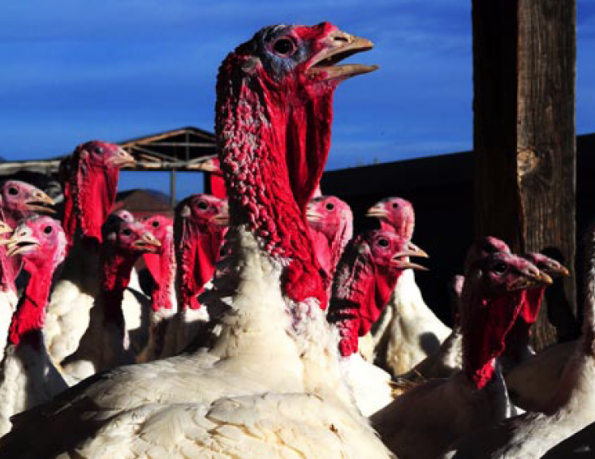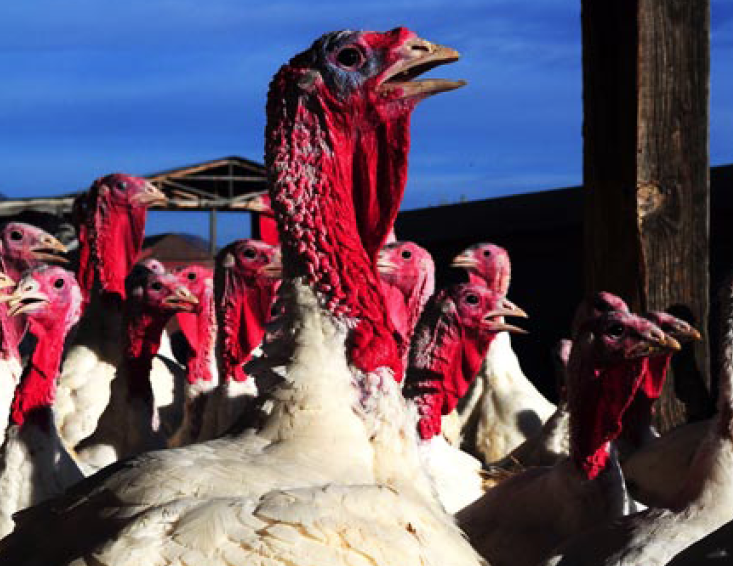 A peek inside a Utah family farm let’s you see what goes into raising the turkey on your table.
A peek inside a Utah family farm let’s you see what goes into raising the turkey on your table.
The turkey of grade school Pilgrim scenes is an iconic brown bird with white, banded feathers. “That’s a heritage bird,” Carol Hess of Wight’s Farm Fresh Turkey explains. “They were the first bird to be bred for commercial purposes.” Over the years, breeding has been influenced and finessed by a marketing bias that has taught the consumer to prefer a clear-skinned bird lacking stains from pin feather ink in the follicle, thus yielding the modern, all-white feathered bird that Carol and her husband, Craig raise on their West Haven farm.
At a current 5,500-bird production capacity, Carol laughs when I ask her to define the activity level of the farm. “It feels way more than a hobby, but I wouldn’t say we’re at a commercial level.” Shaking tail feathers has been in the family for three generations. Carol’s grandfather started Ogden Poultry in 1948, at one time producing 750,000 birds a year, but back then the facilities and operations were more complex than they are today. From her parents, Carol and Craig inherited the current business of producing a true, fresh turkey, a tradition they sustain and that is in sync with the growing urban slow food movement.
The USDA ranks Utah 11th in overall national turkey production. Utah turkey farming started at the beginning of the 20th century with a few growers in Sanpete County. After the Depression, farmers joined together to form farm cooperatives, the largest of which still operating today is the Moroni Feed Company, a “fully integrated turkey producing and processing cooperative” and a strategic partner for the prestigious Utah Norbest label.
As with other commercial agricultural products, turkey breeding has evolved so that there is relatively little genetic diversity among domesticated breeds. The industry standard is a broad breasted white which, as the name implies, yields more breast meat. Farms in Utah used to also include hatcheries, but the climate and high altitude—conditions that are not naturally advantageous to hatching eggs—make it more economical to buy young birds from a hatchery in Missouri. Carol tells me they receive three different shipments from June, through August, allowing them to offer different sized birds throughout the holidays. Their biggest bird to date weighed in at 41 pounds. It would take a big oven to cook that bird!
Wight’s turkeys are raised outdoors, grain-fed and are all natural. “Hormones are not added to the feed. Federal regulation doesn’t allow it,” Carol asserts, “ and we use no growth enhancers.” to keep the cost down, they choose to forgo paying for the USDA certified organic label. “We do as much as everybody else who’s certified, but I can’t see charging $5.00 a pound for turkey.” One practice they absolutely do not engage in is enhancing the processed bird with an injected sodium-based solution, a standard convention in commercial farming. Even birds packaged as being “natural” may still be enhanced, and consumers looking for a true, fresh turkey like the ?s sell are wise to carefully read the label on which producers are required by law to disclose the quantity and name of the solution ingredients.
In addition, the Wight birds live on the farm four weeks longer than commercial farm birds, and, as part of their processing, a Wight turkey is naturally aged in a cooler to enhance. “We won’t sell a same-day processed bird,” Carol declares.
Enclosed metal walls keep predators out of the large pens that house the mixed-gender birds, part of Carol’s grandfather’s original farm, but otherwise the birds are free to do what turkeys do, roam around, peck and gobble. Though the toms and hens know Carol, they become slightly agitated when we enter their living quarters since I am a stranger.
The cacophony of their distress reaches a significant pitch as we wade through strong, feather-covered bodies. The experience is wholly unique and once the birds have decided I am no threat, they begin exploring my personage with their beaks, the pecks not at all aggressive, but decidedly curious. All this, of course, is familiar to Carol who grew up in this milieu, and who also fully understands the value of the farm experience that she is sharing with her granddaughter.
“I’ve always had them in my life,” Carol notes. “In fact it was really hard for me to see the Walmart being built where my grandpa’s processing plant was. My grandpa and I were very close. For me, to stay true to raising and selling a natural turkey honors his memory.”






